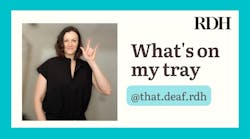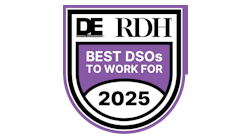There are 54.1 million people over the age of 65 in the United States.1 One in four older adults experience vision loss. Two-thirds go untreated for their hearing deficit.2-4 Any form of sensory deprivation can lead to depression, social isolation, cognitive decline, and a decrease in quality of life.5
As people age, their senses may diminish, making communication and interaction difficult. Special techniques are required when speaking with and creating written materials for older people. Older adults encounter their share of challenges, and there are ways health-care providers can have better communication outcomes with them.
Designing content for the hearing impaired
The National Institute on Aging suggests some tips for people who are hard of hearing.6 A few of these are making an effort to include people with hearing loss in a conversation, finding a quiet place to talk with them, using facial expressions and hand gestures, making eye contact and speaking clearly and slowly, not covering your mouth, and being patient with them.6
Wearing masks and social distancing during the pandemic was detrimental to many older adults with hearing loss. Many rely on lip-reading and facial expressions for contextual communication clues and comprehension.7 When communicating with them, you can rephrase your statement or question instead of repeating the exact words, usie written communication with pen and paper, or text with them.
You can ask a family member to accompany them to their dental appointment. Then try to position yourself before the individual and give them your full attention. Wearing a transparent mask for lip reading, as shown in Figure 1,8 has worked well for me with my patients.Designing content for the vision impaired
For those with poor vision, communicating and comprehending what’s written poses challenges. Written interaction consists of flyers, pamphlets, brochures, and letters. When composing printed materials, consider health literacy, educational level, and socioeconomic status. The average person reads on an eighth-grade level, so materials for the public should be written at an eight-grade reading level at most.8 Microsoft Word has a built-in feature to check the reading level of a document.
The National Institutes of Health (NIH) suggests keeping these ideas in mind when writing for seniors.4 Health fact sheets should be direct and specific. Communication should be clear to reduce misunderstanding. Instead of saying “Exercise daily,” say "Walk for 30 minutes each day." Limit key points, and make messages brief with three to five bullet points for easy recall.
Offer patients a manageable number of action steps. Suggest short-term goals. Use positive statements, such as "Keep your doctor appointments even if you feel fine.” Focus on actions such as, "Reduce sugar intake to decrease the risk of diabetes." Tell stories to connect about past experiences, which can help you bond with older adults.
How to design reader-friendly content
Design written material that’s reader friendly. The NIH suggests typefaces such as Minion Pro, Times New Roman, and Georgia, which create an illusion line to guide the eye across the print. Use large fonts, such as 14-point, and larger for headings. Include white space in the material to allow the eyes to rest. Double-space the body to decrease line blurring. Limit the use of italics, underlining, and bolding, which can confuse older adults.
Left-justified text is the easiest to read. Keep standard spacing between letters and do not abbreviate words. Avoid yellow, blue, and green colors in proximity. Create a contrast between the background and color type, such as black words on a light background. Avoid decorative backgrounds, and limit line length for reading ease. Keep lines around 60 characters per line or use two columns to reduce line length. Using a mnemonic device aids retention and counteracts diminished long-term memory.2 Figure 2 is an example of an oral health promotional flyer.
Multiple strategies can be used to communicate with older adults. Interacting with this population can happen more effectively when you consider the patient’s senses. If you consider these communication strategies, older adult participation in health-care learning and decision-making will be more positive and accepting.
References
1. Heine C, Browning C. Mental health and dual sensory loss in older adults: a systematic review. Front Aging Neurosci. 2014;6:83. doi.10.3389/fnagi.2014.00083
2. Kicklighter J. Characteristics of older adult learners: a guide for dietetics practitioners. J Am Diet Assoc. 1991;91(11):1418-1422. doi.10.1016/S0002-8223(21)42332-1
3. Lin F, Yaffe K, Xia J, et al. Hearing loss and cognitive decline in older adults. JAMA Internal Medicine. 2013;173(4):1-7. doi:10.1001/jamainternmed.2013.1868
4. Hearing loss: A common problem for older adults. National Institute on Aging. 2018. https://www.nia.nih.gov/health/hearing-loss-common-problem-older-adults
5. Pelletier A, Rojas-Roldan L, Coffin J. Vision loss in older adults. AFP. 2016;94(3):219-226.
6. Making your printed health materials senior friendly. National Institute on Aging. https://www.govinfo.gov/content/pkg/GOVPUB-HE20-PURL-LPS116731/pdf/GOVPUB-HE20-PURL-LPS116731.pdf
7. Ten Hulzen RD, Fabry DA. Impact of hearing loss and universal face masking in the COVID-19 era. Mayo Clin Proceedings. 2020;95(10):2069-2072. doi:10.1016/j.mayocp.2020.07.027
8. The Literacy Project. October 9, 2022. https://www.literacyproject.org/
9. 2020 profile of older Americans. US Department of Health and Human Services. 2021:1-21. https://acl.gov/sites/default/files/Aging%20and%20Disability%20in%20America/2020ProfileOlderAmericans.Final_.pdf
Editor's note: This article appeared in the April/May 2024 print edition of RDH magazine. Dental hygienists in North America are eligible for a complimentary print subscription. Sign up here.
Susie Keepper, MSN, APRN, AGCNS-BC, RDH, is an advanced practice nurse, clinical nurse specialist, RDH, and Reynolds Scholar at the University of Oklahoma Health Sciences Center. She completed her dental hygiene degree at Missouri Southern State University, her Bachelor of Science in nursing at Central Methodist University, and her nursing master's and Doctor of Nursing Practice at the University of Oklahoma HSC. Her focus is on introducing dental health in the hospital, interdisciplinary teams, and developing oral health quality improvements for hospitalized older adults.










